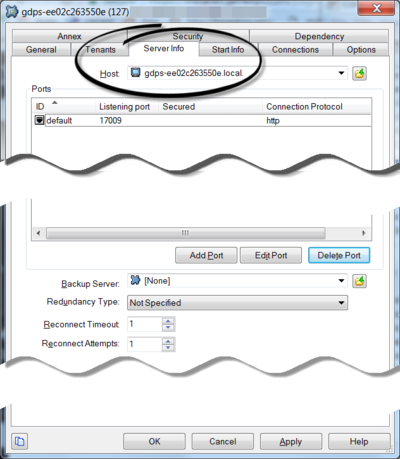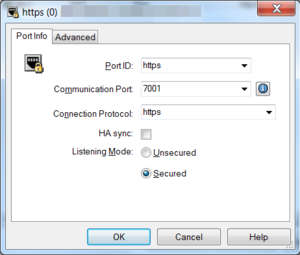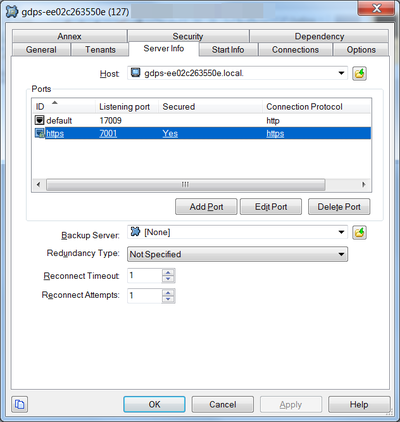Contents
Enabling a Secure Connection via HTTPS for GDPS
This article describes how to enable a secure HTTPs connection in GDPS for a Linux environment. There is a detailed discussion on how to configure SSL for Jetty at the following link: https://wiki.eclipse.org/Jetty/Howto/Configure_SSL
Process
Enabling a secure HTTPS connection in GDPS involves the following steps:
Server side
- Creating a secure port.
- Creating/importing a certificate.
- Updating the Jetty configuration to inject the certificate.
Client side
Server side
Creating a secure port
- Login to Configuration Server and open the GDPS application.
- Select the Server Info tab.
- Click Add Port.
- Click Add Port.
- Create the new secured port by adding the Port ID https. Note that you can't update the default port from http to https.
- Set the value of Communication Port to a free TCP port.
- Set the value of Connection Protocol to https.
- For the value of Listening Mode, check Secured.
- On the Advanced tab, make sure that the Transport Protocol Parameters field contains the string tls=1.
- Click OK to save your changes. When saving, you can safely ignore the Listening Mode certificate warning.
- The configuration should look like this:
Creating/importing a certificate
Creating a certificate
On the GDPS server, you can create a self-signed certificate (for internal or testing purposes) with the Java keytool as follows:
keytool -genkey \
-v \
-alias gdps2 \
-dname #:"CN=192.168.99.100,OU=IT,O=JPC,C=GB" \
-keypass password \
-keystore gdps2.jks \
-storepass password \
-keyalg "RSA" \
-sigalg "MD5withRSA" \
-keysize 2048 \
-validity 365This will create a JKS store named gdps2.jks.
Importing a certificate
Import your signed certificate by using the command below. For a production environment, import your signed certificate into a JKS store.
keytool -keystore keystore -importcert -alias alias -file certificate_file -trustcacertswhere:
- keystore is the name of your JSSE keystore.
- alias is the unique alias for your certificate in the JSSE keystore.
- certificate_file is the name of your certificate file. For example, jetty.crt.
Updating Jetty server to inject certificate
Once you have a certificate (self-signed or imported one), you need to modify Jetty (see the procedure below) so that it fetches your certificate. Jetty provides by default a certificate out of the box. It should be replaced by your certificate.
- Log into the GDPS server.
- Navigate to the GDPS install directory.
- Find the jetty-ssh.xml file. Example: root@ee02c263550e:# cd /gdps/etc root@ee02c263550e:/gdps/etc# ls jetty-ssl.xml jetty-ssl.xml
- Edit this file, replacing the following lines with the path and password of your certificate:
- Original Jetty SSL
<Set name="KeyStorePath"><Property name="jetty.base" default="." />/<Property name="jetty.keystore" default="etc/keystore"/></Set> <Set name="KeyStorePassword"><Property name="jetty.keystore.password" default="OBF:1vny1zlo1x8e1vnw1vn61x8g1zlu1vn4"/></Set> <Set name="KeyManagerPassword"><Property name="jetty.keymanager.password" default="OBF:1u2u1wml1z7s1z7a1wnl1u2g"/></Set> <Set name="TrustStorePath"><Property name="jetty.base" default="." />/<Property name="jetty.truststore" default="etc/keystore"/></Set> <Set name="TrustStorePassword"><Property name="jetty.truststore.password" default="OBF:1vny1zlo1x8e1vnw1vn61x8g1zlu1vn4"/></Set>
New Jetty SSL
Note that the password value should be obfuscated in production mode, using the prefix OBF: .<Set name="KeyStorePath"><Property name="jetty.base" default="." />/<Property name="jetty.keystore" default="gdps2.jks"/></Set> <Set name="KeyStorePassword"><Property name="jetty.keystore.password" default="password"/></Set> <Set name="KeyManagerPassword"><Property name="jetty.keymanager.password" default="password"/></Set> <Set name="TrustStorePath"><Property name="jetty.base" default="." />/<Property name="jetty.truststore" default="gdps2.jks"/></Set> <Set name="TrustStorePassword"><Property name="jetty.truststore.password" default="password"/></Set>
- Save the file.
- Restart GDPS.
Resources
See documentation on jetty: https://www.eclipse.org/jetty/documentation/9.3.x/configuring-security-secure-passwords.html
Example
export JETTY_VERSION=9.2.18.v20160721
java -cp lib/jetty-util-$JETTY_VERSION.jar org.eclipse.jetty.util.security.Password root password
2017-11-24 11:12:50.355:INFO::main: Logging initialized @249ms
password
OBF:1v2j1uum1xtv1zej1zer1xtn1uvk1v1v
MD5:5f4dcc3b5aa765d61d8327deb882cf99
CRYPT:rox7Jdqy.byUUClient side
Confirming/testing with a browser or from the command line
Once GDPS has restarted, test from the client side using either a browser or from the command line.
Browser
From a browser, navigate to the new secured URL—for example, https://192.168.99.100:7001/data/package/packages.
Using curl
From the command line, use curl.
- Make sure that the curl package you are using does support HTTPS by verifying the protocols supported by issuing a curl --version command as follows:
$ curl --version curl 7.43.0 (x86_64-w64-mingw32) libcurl/7.43.0 OpenSSL/1.0.2d zlib/1.2.8 libidn/1.32 libssh2/1.6.0 librtmp/2.3 Protocols: dict file ftp ftps gopher http https imap imaps ldap ldaps pop3 pop3s rtmp rtsp scp sftp smtp smtps telnet tftp Features: IDN Largefile SSPI Kerberos SPNEGO NTLM SSL libz TLS-SRP
- Check that HTTPS is listed. If not, you will get a 'not supported' error message like this one:
curl --cacert C:\tmp\ca.crt https://192.168.99.100:7001/data/package/packages curl: (1) Protocol https not supported or disabled in libcurl
- Once curl is sucessfully checked, retrieve the certificate by using an openssl command. The public certificate is stored in the ca.crt on the client side. Retrieve the certificate by using a command like this one:
openssl s_client -connect 192.168.99.100:7001 -showcerts < /dev/null | openssl x509 -outform PEM > /c/tmp/ca.crt
- Then issue the curl command with the retrieved certificate:
curl --cacert /c/tmp/ca.crt https://192.168.99.100:7001/data/package/packages
Disabling the certificate check
Alternatively, you can disable certicate check with curl by using the -k option (insecure flag) using a command like this one:
curl -k https://192.168.99.100:7001/data/package/packagesDisplaying the certificate
To display the certificate content from the client, use a command like this one:
openssl s_client -connect 192.168.99.100:7001 -showcertsExample:
$ openssl s_client -connect 192.168.99.100:7001 -showcerts
Loading 'screen' into random state - done
CONNECTED(00000134)
depth=0 C = GB, O = JPC, OU = IT, CN = 192.168.99.100
verify error:num=18:self signed certificate
verify return:1
depth=0 C = GB, O = JPC, OU = IT, CN = 192.168.99.100
verify return:1
---
Certificate chain
0 s:/C=GB/O=JPC/OU=IT/CN=192.168.99.100
i:/C=GB/O=JPC/OU=IT/CN=192.168.99.100
-----BEGIN CERTIFICATE-----
MIIDITCCAgmgAwIBAgIESfSLVTANBgkqhkiG9w0BAQQFADBBMQswCQYDVQQGEwJH
QjEMMAoGA1UEChMDSlBDMQswCQYDVQQLEwJJVDEXMBUGA1UEAxMOMTkyLjE2OC45
OS4xMDAwHhcNMTcxMTI0MDgyNTM5WhcNMjcxMTIyMDgyNTM5WjBBMQswCQYDVQQG
EwJHQjEMMAoGA1UEChMDSlBDMQswCQYDVQQLEwJJVDEXMBUGA1UEAxMOMTkyLjE2
OC45OS4xMDAwggEiMA0GCSqGSIb3DQEBAQUAA4IBDwAwggEKAoIBAQCZiNgEWisR
jGbMDfGLC52dMYblQtC305J0kKqTz675Cc/6AIa/i2KrxJ33nUYb8T9D8b9Y66rt
vzdAZfhirUE9A1xMiIyQqMNa+PahxhpgaYK26u/ev2YGI3EGrQfDXT1lNbp7pqaS
LaGLK5Dmpo21Ef0sfVnYa8VTc4uI3Q0kqhp2l0MdiHXDvgp6peursRoe6YVbAoV0
acrc19PRFcN6Iir+32wsSjOf8DlxbypfbQf1BK4V26SyNWi5DD4gEajPfVQfuh+s
dOum1egvvvO0j60HNPSFxJLWPsG2x+3L+9pA+WsmJ8DSRktCimsdH69V9jNKp36k
Kjz1CMCQogrvAgMBAAGjITAfMB0GA1UdDgQWBBQMqJkbaW5STz1JrNb9jh6ySlQy
bjANBgkqhkiG9w0BAQQFAAOCAQEAaEAkdMEd0P9yC1o3cWkKXWTs0aQduGKV4K1x
drCGTnwzPG2bszOz4VfZWpHjKlBv+Yeo+FR/Bz6Y/ByBmjjkGEAKXwoHnon8qcs+
xEc9l79c904vbB6WOW3BG5LmoyyXeYuOpJ0qHFUVpHmrz8sDwK57FS3kASomH0Y1
5daTXWSt/XHyNccaJdRTf1PAtzE7fo/tTw2l8jvQzBycPXi88fV2gTiTXst2Jzxq
Hvp+JqkRc9P2KMqq3TW3lmVJ2jHNyegrNAsfHFh/oHWu4Z0xxDD25KtWrR7Nxu+p
6BXNI2E4ZvHiMCYwna+ThjgT+OaH+HhXcRtfQX/Hjkl+aqdoPQ==
-----END CERTIFICATE-----
---
Server certificate
subject=/C=GB/O=JPC/OU=IT/CN=192.168.99.100
issuer=/C=GB/O=JPC/OU=IT/CN=192.168.99.100
---
No client certificate CA names sent
Peer signing digest: SHA512
Server Temp Key: ECDH, P-256, 256 bits
---
SSL handshake has read 1289 bytes and written 444 bytes
---
New, TLSv1/SSLv3, Cipher is ECDHE-RSA-AES128-GCM-SHA256
Server public key is 2048 bit
Secure Renegotiation IS supported
Compression: NONE
Expansion: NONE
No ALPN negotiated
SSL-Session:
Protocol : TLSv1.2
Cipher : ECDHE-RSA-AES128-GCM-SHA256
Session-ID: 5A17F573EBE27C68EBD5213F42349E364EBDC39325D36E59D0BAF9965BC4905C
Session-ID-ctx:
Master-Key: B353A0A3A8158CE021F9ED2516AB8422D410DBF8EFA4D6AC8445C07AF7A1B14AAEF8BC6E3BB677EA7FDEFEA2048A07EE
Key-Arg : None
PSK identity: None
PSK identity hint: None
SRP username: None
Start Time: 1511519603
Timeout : 300 (sec)
Verify return code: 18 (self signed certificate)
---
closedOther resources
- https://www.eclipse.org/jetty/documentation/9.3.x/configuring-security-secure-passwords.html
- Download a curl for Windows that supports HTTPS from this location: https://curl.haxx.se/download.html



